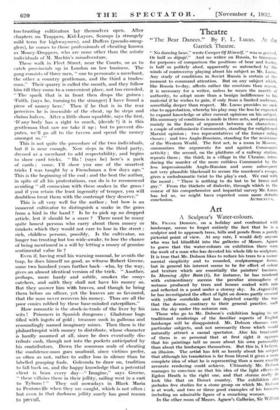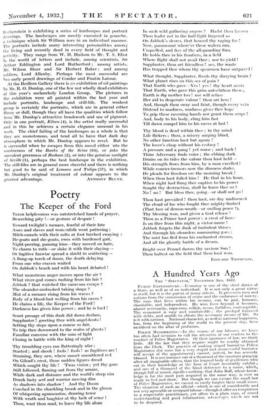Art
A Sculptor's Water-colours.
MR. FRANK DOBSON, on a holiday and confronted with landscape, seems -to forget entirely the fact that he is a sculptor and to approach trees, hills and ponds from a purely pictorial point of view. At any rate, I would defy anyone who was led blindfold into the galleries of Messrs. Agnew to guess that the water-colours on exhibition there were the work of a man who has devoted his whole life to sculpture. It is true that Mr. Dobson likes to reduce his trees to a monu- mental simplicity and to rounded, sculpturesque forms, but in general his interest seems to be for effect of colour and texture which are essentially the painters' business. In Morning After Rain (1), for instance, he has rendered with extraordinary success the peculiar atmosphere of wetness produced by trees and houses soaked with rain and reflected in a pond under a stormy sky. In August (14) he has investigated the effect of light on downs partly covered with yellow cornfields and has depicted exactly the way that the downs, contrary to their general practice, melt into the sky under the autumn sun.
Those who go to Mr. Dobson's exhibition hoping to see traditional renderings of the familiar aspects of English landscape will be disappointed. Mr. Dobson chooses very particular subjects, and not necessarily those which would naturally attract a casual spectator. Also his treatment of them is so personal that at first sight it appears that his paintings tell us more about his own personality than about the landscapes themselves. But this is, I believe, an illusion. The artist- has felt so keenly about his subject that although his translation is far from literal it gives a more complete idea of what he is representing than a more exactly accurate rendering could achieve. Ultimately Mr. Dobson manages to convince us that his idea of the .light effects on Egdon Heath is the right one, and that storms really do look like that on Dorset country. The exhibition also includes five studies for a stone group on which Mr. Dobson is at work, and two or three good examples of his bronzes, including an admirable figure of a crouching woman.
In the other room of Messrs. Agnew's Galleries, Sir Willi:1M
Rothenstein is exhibiting a series of landscapes and portrait drawings. The landscapes are mostly executed in gouache, a technique which Sir William uses in an individual manner. The portraits include many interesting personalities among the living and recently dead in every field of thought and activity. They range from W. H. Hudson to Mr. T. S. Eliot in the world of letters and include, among scientists, Sir Arthur Eddington and Lord Rutherford ; among artists, Mr. Wilson Steer and Sir Herbert Baker ; and among soldiers, Lord Allenby. Perhaps the most successful are two early pencil drawings of Conder and Fautin Latour.
At the Redfern Gallery there is an exhibition of oil paintings by Mr. R. 0. Dunlop, one of the few not wholly dead exhibitors at this year's melancholy London Group. The pictures in the exhibition were all painted within the last year and include portraits, landscape and still-life. The weakest group is certainly the portraits, which are in general either flimsy or dull, though they all have the qualities which follow from Mr. Dunlop's attractive brushwork and use of pigment. Only in one portrait, Eileen (4), is the artist really successful and in this he achieves a certain elegance unusual in his work. The chief failing of the landscapes as a whole is that they are monotonous, and tend all to have that dark day atmosphere in which Mr. Dunlop appears to revel. But he is successful when he escapes from this mood either 'nto the sombreness of the Banks of the Seine (64), or into the succulent greenness of Bosham (2), or into the genuine sunlight of Seville (1), perhaps the best landscape in the exhibition. The still-lifes are in general more cheerful and there is nothing but good to be said of Lemons and Tulips (57), in which Mr. Dunlop's original treatment of colour appears to the











































 Previous page
Previous page